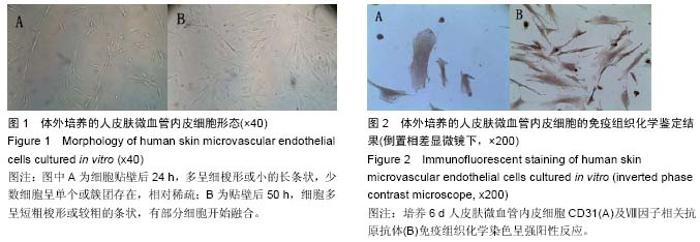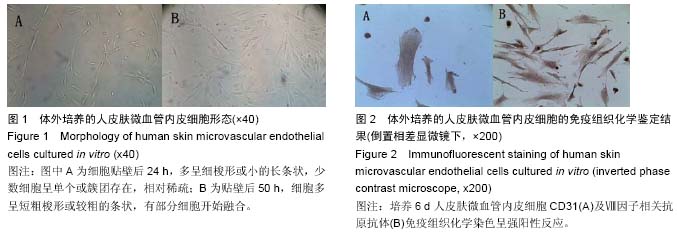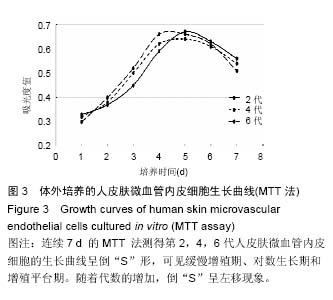| [1] 赵景宏,黄岚,王军平,等.大鼠肾小球内皮细胞培养及高糖对其分泌NO的影响[J].免疫学杂志,2007,23(1):13-15.[2] 瞿海龙,陈晓春.大鼠胸主动脉内皮细胞培养方法的改进[J].内蒙古医学院学报,2007,29(3):164-166.[3] 王征,齐炜炜,陈少波,等.一种高选择性、高效的牛视网膜微血管内皮细胞培养方法[J].热带医学杂志,2012,12(1): 1-3+21.[4] 贾建桃,张慧英,王黎敏,等.肺微血管内皮细胞原代培养方法的建立[J]. 细胞与分子免疫学杂志,2014,30(7): 763-766.[5] 彭岳,李树民,黎桂玉,等.肝窦内皮细胞分离、培养与鉴定的研究概况[J].世界华人消化杂志,2015,23(5):728-734.[6] 黄健兵,龚德军,胡丰庆,等.兔静脉血管内皮及平滑肌细胞原代培养方法的改进及鉴定[J].山东医药,2008,48(27): 35-36.[7] 王莉,张端莲,陕声国,等.血管瘤内皮细胞培养方法的改进及鉴定[J].数理医药学杂志,2005,18(6):12-13.[8] 葛敏,蒋朝华,戴婷婷,等.不同血清浓度对淋巴管内皮细胞培养的影响[J].组织工程与重建外科杂志,2013,9(3): 121-124.[9] 彭岳,李树民,黎桂玉,等.肝窦内皮细胞分离、培养与鉴定的研究概况[J].世界华人消化杂志,2015,23(5):728-734.[10] 李玉珍,刘秀华,蔡莉蓉.改良的心肌微血管内皮细胞分离培养方法[J]. 微循环学杂志,2006,16(4):10-11.[11] 王荫静,朱美财,占志,等.牛肾上腺毛细血管内皮细胞的长期培养及用于测定内皮细胞抑素活性[J]. 细胞与分子免疫学杂志,2001,17(1):88-89.[12] 张慧丽,杜培丽,方元龙,等.人皮肤微血管内皮细胞的分离培养及鉴定[J].中国组织工程研究,2014,18(11): 1706-1711 [13] 朱澄,邱孝芝. 兔和人角膜内皮细胞培养方法研究[J].中国眼耳鼻喉科杂志,2000,5(2):3-7.[14] 张军霞,向光大,孙慧伶,等.α-硫辛酸对高糖作用下人脐静脉内皮细胞护骨素表达的影响[J]. 中国糖尿病杂志, 2010, 18(8):579-581.[15] Yan LF, Wei YN, Nan HY, et al. Proliferative phenotype of pulmonary microvascular endothelial cells plays a critical role in the overexpression of CTGF in the bleomycin- injured rat.Exp Toxicol Pathol. 2014;66(1): 61-71.[16] Sölder E, Böckle BC, Nguyen VA, et al. Isolation and characterization of CD133+CD34+VEGFR-2+CD45- fetal endothelial cells from human term placenta. Microvasc Res.2012;84(1): 65-73.[17] An P, Xue YX. Effects of preconditioning on tight junction and cell adhesion of cerebral endothelial cells. Brain Res.2009;1272:81-88.[18] Nguyen VA, Fürhapter C, Obexer P, et al.Endothelial cells from cord blood CD133+CD34+ progenitors share phenotypic,functional and gene expression profile similarities with lymphatics. J Cell Mol Med. 2009;13(3):522-534.[19] Dye JF, Vause S, Johnston T, et al. Characterization of cationic amino acid transporters and expression of endothelial nitric oxide synthase in human placental microvascular endothelial cells. FASEB J. 2004; 18(1): 125-127.[20] Laranjeira MS, Fernandes MH, Monteiro FJ.Reciprocal induction of human dermal microvascular endothelial cells and human mesenchymal stem cells: time-dependent profile in a co-culture system. Cell Prolif.2012;45(4):320-334.[21] Talavera-Adame D, Ng TT, Gupta A,et al. Characterization of microvascular endothelial cells isolated from the dermis of adult mouse tails. Microvasc Res. 2011;82(2):97-104.[22] Sievers H, Bahramsoltani M, Kässmeyer S,et al.In vitro angiogenic potency in human microvascular endothelial cells derived from myocardium, lung and skin. ClinHemorheolMicrocirc. 2011;49(1-4):473-486.[23] Dunk CE, Roggensack AM, Cox B, et al. A distinct microvascular endothelial gene expression profile in severe IUGR placentas.Placenta.2012;33(4):285-293.[24] Ugele B, Lange F.Isolation of endothelial cells from human placental microvessels: effect of different proteolytic enzymes on releasing endothelial cells from villous tissue. In Vitro Cell Dev Biol Anim.2001;37(7): 408-413.[25] 贾建桃,张慧英,王黎敏,等.肺微血管内皮细胞原代培养方法的建立[J]. 细胞与分子免疫学杂志,2014,29(7): 763-766.[26] 瞿海龙,陈晓春.大鼠胸主动脉内皮细胞培养方法的改进[J]. 内蒙古医学院学报,2007,48(3):164-166.[27] 殷杰,马珍妮,赵小娟,等.人外周血来源的过度生长内皮细胞的分离、培养及鉴定[J].中国实验血液学杂志,2014, 21(6):1711-1715.[28] 张步春,王安才,李利芳,等.血管内皮细胞体外培养方法的实验研究[J]. 实用医学杂志,2009,37(7):1048-1049.[29] 黎胜苗,罗春芬,卢兰琴,等.原代人脐静脉内皮细胞分离培养模型的建立[J].医学研究杂志,2013,41(5):94-96.[30] 黄盛东,刘晓红,杨立信,等.血管内皮细胞生长因子基因转染诱导大鼠骨髓基质干细胞分化为内皮细胞[J]. 第二军医大学学报,2003,23(12):1280-1283[31] State Council of the People's Republic of China. Administrative Regulations on Medical Institution. 1994-09-01.[32] 常冰梅,李美宁,刘志贞,等.肝细胞生长因子基因转染对人脐静脉内皮细胞增殖、迁移的影响[J]. 中国免疫学杂志, 2011,26(8):686-690.[33] 刘婷,杜雪莲,盛修贵,等.人卵巢上皮癌微血管内皮细胞分离培养与鉴定[J].中华肿瘤防治杂志,2013,19(15): 1168-1171.[34] Rohde LH, Janatpore MJ, McMaster MT, et al. Complementary expression of HIP, a cell-surface heparin sulfate binding protein, and perlecan at the human fetal-maternal interface. BiolReprod. 1998; 58(4):1075-1083.[35] Lang I, Schweizer A, Hiden U, et al. Human fetal placental endothelial cells have a mature arterial and a juvenile venous phenotype with adipogenic and osteogenic differentiation potential. Differentiation. 2008;76(10):1031-1043. |



